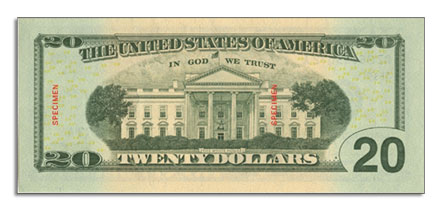|
After repeated warnings
from currency analysts and market advisors (including
yours truly) that the U.S. currency system is on the
verge of becoming a blocked, two-tier system we now have
confirmation that the country is one step closer to
realizing this. When fully implemented, the new U.S.
dollar will mean a "banana republic" type currency and
across-the-board devaluation.
According to a CNN/Money
news wire report of Oct. 7, the new U.S. $20 bills will
be released this week at banks across the country.
Meanwhile, the Fed and its Bureau of Engraving and
Printing (BEP) will hold a nationwide series of
publicity events as part of a $33 million campaign to
let the world know of the new bills and to acclimate the
public to their strange new appearance.
The new $20s are
peach-toned with the presence of blue ink, making it the
first time in almost 100 years that a mass-circulation
U.S. note has prominently contained a color besides
green and black. They also contain an embedded vertical
plastic strip and color-shifting ink, whose appearance
changes from copper to green as the bill is tilted
against the light. Below is what the front of the new
$20 bill looks like (from the BEP website). [Editor's
note, which has a really odd name: the Money Factory]

So what is the
significance of this change of color in the U.S. $20
note? Well according to the Feds it is designed as a
deterrent to stop counterfeiters. But accordingly to
currency analyst Lawrence Patterson, who authored the
1994 monograph titled "Currency Recall," which
accurately forecast the new multi-colored notes, the new
colored money is part of a two-tiered currency system
that will have drastic implications for investors and
non-investors alike here in the U.S.
Patterson calls the new
notes "crayola currency" and claims they will circulate
domestically while the normal green currency that we've
grown accustomed to will circulate offshore all over the
globe. According to commentator Terry Savage,
"Two-thirds of the U.S. paper currency is circulating in
foreign countries." With the coming two-tiered currency
system, foreigners will continue to be allowed to use
the greenback while U.S. citizens will be stuck with the
"crayola currency" which cannot be exchanged.
The Coming Currency
Devaluation
Patterson forecasts the
coming use of foreign exchange controls for the U.S.
dollar domestically, which would prohibit Americans from
transferring capital to any other world currency. Again,
this is discussed in Patterson's now-classic monograph
"Currency Recall" (which I've read and highly recommend
to students of currency policy and investors seeking to
retain the value of their investments). Buy from Amazon.
Patterson states, "I want
every one... to think carefully about this... because we
are coming very, very close to the end of the freely
convertible domestic dollar. The cut in value could be
as much as 50%... I believe those holding gold bullion
bars offshore and bullion coins domestically will be
very surprised to find that special regulations will
prohibit them from profiting."
He further maintains that
coin dealers are under a strict Treasury regulation and
must report your sales of some coins but not others. The
rule is as follows: Coins with a premium above 15% do
not have to be reported. In addition to the 1099 report,
filed by the coin dealer, you have to declare any
capital gains as well."
He continues, "The
existence of this rule, I believe, indicates an intent
to outlaw the ownership of bullion coins altogether!
However, the rule will not remain at 15% necessarily and
could be changed to a higher percentage, which is
unknown at this time. Obviously, you do not want to own
any investment coins with a premium of 15% or less and
better stay at the 25% or 30% level to be safe."
Patterson points out that complications for the
government would clearly arise should numismatic
collectibles be forcibly confiscated since the bullion
coins' value can be determined by the London gold fix,
but not so for collectibles. "The price of the
collectible coin may or may not be easily determined as
numismatic valuables are routinely auctioned off at
prices of not only tens of thousands of dollars, but
hundreds of thousands of dollars per item," he observes.
"It is difficult to imagine just how this would all be
sorted out by the bureaucracy to come up with a
calculation of compensation that would relate to the
market value." He advises staying in the "safe zone" and
exchanging bullion coins not needed for emergencies
(such as food or gasoline shortages, et al) for
numismatic coins with higher premiums.
Obviously, the
introduction of the new peach-colored $20 bill is a test
on the American public to see how they respond to the
drastic new changes. The CNN/Money article states that
the BEP has launched a multi-million dollar promotional
campaign aimed at gaining public acceptance of the new
currency. For example, the twenties are being featured
on game shows, including "Wheel of Fortune" and
"Jeopardy," sporting events, like ESPN's college
football telecasts. The bills are also part of some
consumer product tie-ins, according to CNN/Money, and
pictures of the bills will be on the side of bags of
Pepperidge Farm Goldfish. If the government succeeds in
getting the American public to accept the bills, the
other remaining denominations will obviously follow and
plans will proceed for the blocked domestic dollar.

|